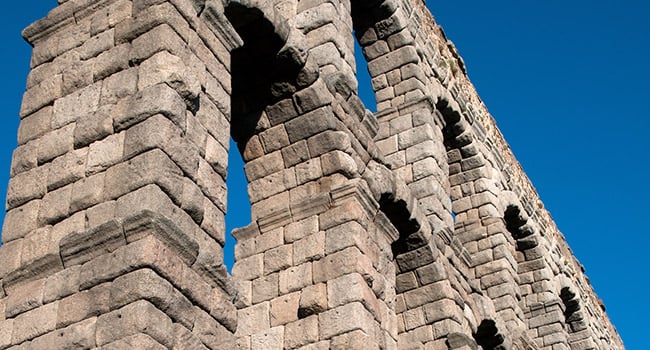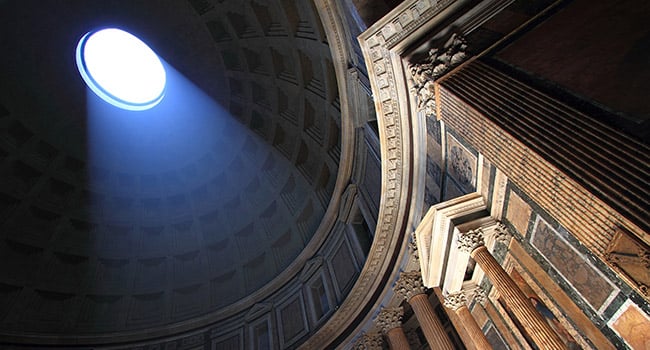Pumice and Roman Concrete

ABOVE: Roman concrete structures, like this aquaduct, have defied the ravages of time for two millenna. BELOW: The Pantheon is a monument to Roman architecture and materials design. The dome of the former Roman temple is made from unreinforced pumice concrete.

THE CONCRETE mix design Roman engineers developed stands as a historically impressive architectural feat. The Roman Empire—temples, roads, aqueducts, piers, arenas—was built from this impressive concrete. 2000 years later, many of those concrete structures are still there. Their concrete was so good they built daring structures that still impress—and are without equal—today. The Pantheon and its huge, unreinforced 142-foot concrete dome, for example. David Moore, author of The Roman Pantheon: The Triump of Concrete wrote: “Made entirely out of concrete, without the reinforcing support of structural steel, no modern engineer would dare attempt such a feat.” Nor would modern building engineering codes allow it—today’s Portland cement concrete simply isn’t good enough.
The Romans didn’t have a quick-setting cement like we do today, rather, they used hydrated lime—a cementitious product made from limestone that was heated to drive off the carbon dioxide and transform the Calcium Carbonate into Calcium Oxide (lime)—and water. Lime does not act like a hydraulic cement on its own, and will only form Calcium Silicate Hydrate (C-S-H)—the all-important cementitious binder that makes concrete work—in the presence of water and pumice (pozzolan).
WHY IT WORKS
When lime and water are mixed with a finely graded amorphous silica (known to the Romans as pulvis puteolanus; referred to today as volcanic ash or pumice pozzolan), nearly 100% of the lime is converted to the cementitious binder chemical C-S-H. That’s important: in modern Portland-cement-based formulations, the hydraulic reaction that forms the C-S-H binder happens quickly without the need for pumice pozzolan—but that speed comes at a performance cost: the fast-setting, pozzolan-starved reaction forms a deleterious by-product—Calcium Hydroxide (CH)—at the expense of critical C-S-H.
This CH by-product not only contributes nothing to concrete strength and durability, it instigates a handful of problems that actively work against and drastically affect the integrity of the concrete. When the CH migrates out of the concrete’s interior via capillary action, it leaves behind an interlaced network of wormholes that both weaken the concrete and compromise density and allow for the future ingress of water contaminated with sulfates, chlorides, and other damaging chemicals at the attack concrete itself as well as the reinforcing steel.
FIXING PORTLAND CEMENT
Fast-setting Portland cement is here to stay—but it’s poor performance and short life span can easily be fixed. The correction is made in the mix design by a percentage-of-cement-replacement addition of the same pozzolanic pumice powder that made Roman concrete so impressive.
An extensive body of research[01] details how pozzolan-charged concrete mix designs ignite a secondary (pozzolanic) reaction that repurposes deleterious CH into additional C-S-H. And that newly-created C-S-H does what you’d expect: it further densifies and strengthens the concrete, welding the aggregates into a dense, durable, almost impermeable matrix. This pozzolanic reaction—a molecular reclamation process, if you will—continues until the pozzolan is used up.
01—Download a summary of the pumice pozzolan research from the University of Texas-Austin and the University of Utah.
More Information on Roman Concrete
—BusinessWeek article: Ancient Roman Concrete Is About to Revolutionize Modern Architecture
—History Channel article: The Secrets of Ancient Roman Concrete
—Article: Riddle of Ancient Roman Concrete (RomanConcrete.com)
—Wikipedia page: Roman Concrete

